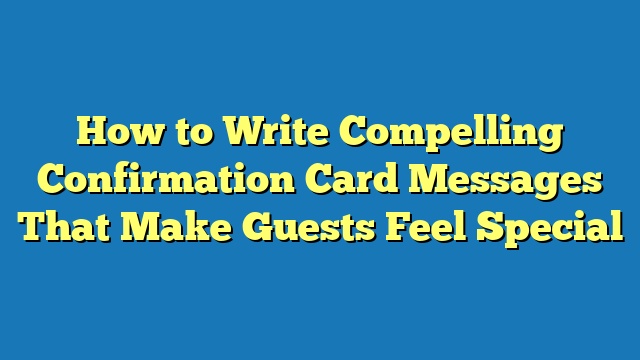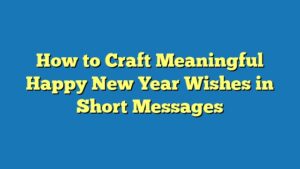A confirmation card message is a short, personalized message that is written on a confirmation card to thank someone for attending an event or RSVPing to an invitation. For example, “Thank you for confirming your attendance. We look forward to seeing you there!” Confirmation card messages are a way to show appreciation and make guests feel welcome.
Confirmation card messages are important because they help to ensure that guests know the details of the event and that they are expected to attend. They can also be used to provide additional information about the event, such as dress code or parking instructions. Historically, confirmation card messages were handwritten, but today they are often printed on the card itself or sent electronically.
In this article, we will discuss the different types of confirmation card messages, how to write a good confirmation card message, and the etiquette of sending confirmation cards. We will also provide tips for using confirmation card messages to promote your event.
Confirmation Card Message
Confirmation card messages are an important part of event planning. They help to ensure that guests know the details of the event and that they are expected to attend. They can also be used to provide additional information about the event, such as dress code or parking instructions.
- Gratitude: Expressing thanks for the guest’s confirmation.
- Confirmation: Stating that the guest’s attendance is confirmed.
- Details: Providing information about the event, such as time, date, and location.
- Dress code: Indicating the appropriate attire for the event.
- Parking: Providing information about parking arrangements.
- RSVP: Requesting that the guest RSVP by a certain date.
- Additional information: Providing any other relevant information about the event.
- Personalization: Adding a personal touch to the message, such as the guest’s name or a reference to a previous conversation.
- Call to action: Encouraging the guest to take a specific action, such as purchasing tickets or donating to a charity.
- Timeliness: Sending the confirmation card message promptly after the guest RSVPs.
These key aspects of confirmation card messages help to ensure that guests have all the information they need to attend the event and that they feel appreciated. Confirmation card messages can also be used to promote the event and to build relationships with guests.
Gratitude
Gratitude is an essential element of any confirmation card message. It shows the guest that you appreciate their decision to attend your event. There are many different ways to express gratitude in a confirmation card message. Here are four common facets of expressing gratitude:
- Sincere appreciation: Expressing genuine thanks for the guest’s confirmation. This can be done with a simple statement like “Thank you for confirming your attendance.” or “We are so grateful that you will be able to join us.”
- Specific acknowledgment: Thanking the guest for something specific, such as their prompt RSVP or their willingness to travel to attend the event. For example, “Thank you for RSVPing so promptly. It helps us to finalize our plans.” or “We appreciate your willingness to travel to attend our event.”
- Personal touch: Adding a personal touch to your expression of gratitude. This could be a reference to a previous conversation or a shared experience. For example, “We are so excited to see you again at our event. It’s been too long!” or “Thank you for confirming your attendance. We know you have a busy schedule, so we appreciate you making time for us.”
- Call to action: Encouraging the guest to take a specific action, such as purchasing tickets or donating to a charity. For example, “Thank you for confirming your attendance. Please purchase your tickets by [date].” or “Thank you for confirming your attendance. We hope you will consider making a donation to our charity.”
By expressing gratitude in your confirmation card message, you can show guests that you appreciate their decision to attend your event and make them feel welcome. Gratitude is a simple but powerful way to build relationships and create a positive experience for your guests.
Confirmation
Confirmation is a critical component of a confirmation card message. It lets the guest know that their attendance is expected and that they have a place at the event. Without confirmation, the guest may not be sure if their RSVP was received or if they are actually invited to the event. This could lead to confusion and disappointment.
There are many different ways to confirm a guest’s attendance in a confirmation card message. Some common phrases include:
- “We are pleased to confirm your attendance at [event name].”
- “Your RSVP has been received and your attendance is confirmed.”
- “We look forward to seeing you at [event name].”
In addition to confirming the guest’s attendance, the confirmation card message may also include other information, such as the time and date of the event, the location of the event, and any special instructions. For example, the confirmation card message may include a dress code or a request to bring a dish to share.
Confirmation card messages are an important part of event planning. They help to ensure that guests know the details of the event and that they are expected to attend. They can also be used to provide additional information about the event and to build relationships with guests.
Details
In the context of confirmation card messages, providing details about the event is essential for ensuring that guests have all the information they need to attend. These details may include the time, date, and location of the event, as well as any other relevant information, such as dress code or parking instructions.
- Time: The time of the event should be clearly stated in the confirmation card message. This may include the start and end time, as well as any specific times for activities or events within the event.
- Date: The date of the event should also be clearly stated in the confirmation card message. This may include the day, month, and year, as well as any specific dates for multiple-day events.
- Location: The location of the event should be clearly stated in the confirmation card message. This may include the name and address of the venue, as well as any specific directions or parking instructions.
- Other details: In addition to the time, date, and location, the confirmation card message may also include other relevant details about the event. This could include information about dress code, parking, or any other special instructions.
By providing all of the necessary details about the event, confirmation card messages help to ensure that guests have a positive experience and that they are able to attend the event without any confusion or inconvenience.
Dress code
In the context of confirmation card messages, providing information about the dress code is essential for ensuring that guests know what to wear to the event. This is especially important for events that have a specific dress code, such as formal or black-tie events. By including the dress code in the confirmation card message, guests can avoid any confusion or embarrassment about what to wear.
For example, a confirmation card message for a formal wedding might include the following statement: “Dress code: Formal attire is required.” This would let guests know that they should wear their best suits or dresses to the wedding. Similarly, a confirmation card message for a casual party might include the following statement: “Dress code: Casual attire is welcome.” This would let guests know that they can dress comfortably for the party.
Providing information about the dress code is a critical component of confirmation card messages because it helps guests to feel prepared for the event. When guests know what to wear, they can relax and enjoy themselves without having to worry about whether or not they are dressed appropriately.
Parking
Parking information is a crucial component of confirmation card messages, especially for events held at venues with limited parking or in busy areas. By providing clear and concise parking instructions, confirmation card messages help guests to plan their transportation and avoid any confusion or inconvenience on the day of the event.
For example, a confirmation card message for a wedding at a downtown venue might include the following statement: “Parking is available in the public lot adjacent to the venue. Please allow extra time for parking, as spaces may be limited.” This would let guests know where to park and how to prepare for potential parking challenges.
In addition to providing general parking information, confirmation card messages can also include specific instructions for guests with disabilities or special needs. For example, a confirmation card message for a conference might include the following statement: “Accessible parking spaces are available upon request. Please contact the event organizer for more information.” This would let guests with disabilities know that they can make arrangements for accessible parking in advance.
Overall, providing parking information in confirmation card messages is essential for ensuring that guests have a positive experience and that they are able to attend the event without any unnecessary stress or inconvenience.
RSVP
In the context of confirmation card messages, including an RSVP request is crucial for event planning. It allows the host to gauge the number of attendees, finalize arrangements, and communicate any necessary updates or changes to the guests. This RSVP request typically includes a deadline for the guest to respond, ensuring that the host has sufficient time to plan accordingly.
-
Deadline Clarity:
The RSVP request should specify a clear and reasonable deadline for guests to respond. This allows guests ample time to make a decision and provides the host with a cutoff point for finalizing arrangements.
-
Response Options:
The RSVP request should provide clear instructions on how guests can respond. This may include providing a dedicated RSVP card, an online RSVP form, or a phone number or email address to contact.
-
Attendance Confirmation:
The RSVP request may also include a section for guests to confirm their attendance or decline the invitation. This information is essential for the host to finalize headcounts and make arrangements for seating, catering, and other event logistics.
-
Additional Information:
The RSVP request can also be used to gather additional information from guests, such as meal preferences, dietary restrictions, or seating requests. This information can help the host plan a more personalized and enjoyable event for their guests.
By including an RSVP request in confirmation card messages, hosts can efficiently manage guest responses, finalize event arrangements, and ensure a smooth and successful event experience for all attendees.
Additional information
Confirmation card messages often include additional information about the event to provide guests with a comprehensive understanding of what to expect. This information can range from details about the event’s program and activities to practical considerations like parking and seating arrangements.
- Event program: The confirmation card message can include a brief overview of the event’s program, outlining the sequence of activities, speakers, or performances. This helps guests plan their schedules and prioritize which parts of the event they want to attend.
- Activities and attractions: For events with multiple activities or attractions, the confirmation card message can provide a list or description of these offerings. This gives guests a sense of the variety and scope of the event, allowing them to tailor their experience to their interests.
- Parking and transportation: If parking is limited or the event venue is not easily accessible by public transportation, the confirmation card message should include clear instructions on parking arrangements. This helps guests plan their transportation and avoid any confusion or inconvenience.
- Seating arrangements: For events with assigned seating, the confirmation card message can indicate the guest’s seat number or table assignment. This eliminates uncertainty and ensures a smooth seating process.
By providing additional information about the event, confirmation card messages help guests feel informed and prepared. This enhances their overall experience and allows them to participate fully in the event’s activities and festivities.
Personalization
In the realm of confirmation card messages, personalization is a key aspect that elevates the guest experience and fosters a sense of connection. It involves adding thoughtful touches that make the message unique and meaningful to the recipient, strengthening the bond between the sender and the guest.
- Name Recognition: The most basic form of personalization is addressing the guest by their name. This simple gesture demonstrates that the sender values the guest as an individual and has taken the time to acknowledge them specifically.
- Personalized Salutation: Beyond using the guest’s name, a personalized salutation can further enhance the message. Instead of a generic “Dear Guest,” consider using a more specific salutation, such as “Dear [Guest’s Name], esteemed colleague,” or “My dearest friend, [Guest’s Name].”
- Reference to Previous Interaction: If you have had a previous interaction with the guest, mentioning it in the confirmation card message adds a personal touch. This could be a reference to a conversation you had, a project you worked on together, or even a shared interest.
- Customized Content: The body of the confirmation card message can also be tailored to the guest’s interests or preferences. For instance, if you know the guest is particularly excited about a specific aspect of the event, you can highlight that in the message.
In conclusion, personalization in confirmation card messages is a powerful tool that conveys appreciation, builds relationships, and creates a memorable experience for guests. By incorporating these personalized elements, you can elevate your confirmation card messages and leave a lasting impression on your guests.
Call to action
In the context of confirmation card messages, including a call to action encourages the guest to take a specific action, such as purchasing tickets or donating to a charity. This strategic element plays a crucial role in driving desired outcomes and maximizing guest engagement.
- Ticket Sales: Confirmation card messages can include a clear call to action for guests to purchase tickets for the event. This may involve providing a link to the online ticketing platform or specifying the steps to purchase tickets offline.
- Charitable Donations: Confirmation card messages can encourage guests to make a donation to a charity associated with the event or cause. This call to action can include information about the charity’s mission and the impact of donations.
- RSVP Confirmation: In cases where RSVP is required, the confirmation card message can serve as a reminder and encourage the guest to confirm their attendance promptly. This helps the host plan accordingly and manage guest numbers.
- Feedback and Surveys: Confirmation card messages can include a call to action for guests to provide feedback or complete a survey after the event. This feedback can be valuable for improving future events and enhancing the guest experience.
By incorporating a call to action into confirmation card messages, organizers can increase ticket sales, encourage charitable contributions, ensure timely RSVPs, and gather valuable feedback. These actions contribute to the success and impact of the event.
Timeliness
In the context of confirmation card messages, timeliness plays a crucial role in ensuring a positive guest experience and effective event planning. Sending the confirmation card message promptly after the guest RSVPs demonstrates respect for the guest’s time and decision, and contributes to the overall success of the event.
- Acknowledgement and Appreciation: Sending a timely confirmation card message shows the guest that their RSVP has been received and appreciated. This prompt acknowledgement conveys professionalism and sets a positive tone for the guest’s participation in the event.
- Planning and Logistics: For events with limited capacity or specific arrangements, sending confirmation card messages promptly is essential for the host to finalize plans and logistics accordingly. It allows the host to accurately track RSVPs and make necessary adjustments, such as confirming venue arrangements or ordering supplies.
- Guest Confidence: Receiving a confirmation card message promptly provides reassurance to the guest that their attendance is confirmed and that they have a place at the event. This clear communication eliminates any uncertainty or anxiety for the guest, allowing them to plan their schedule and arrangements accordingly.
- Event Promotion and Engagement: A timely confirmation card message can also serve as an opportunity to promote the event and build excitement among guests. By including details about the event’s program, activities, or special features, the confirmation card message can generate enthusiasm and encourage guests to actively participate in the event.
In conclusion, sending confirmation card messages promptly after the guest RSVPs not only acknowledges the guest’s response but also contributes to effective event planning and enhances the overall guest experience. By demonstrating respect for the guest’s time and providing clear and timely communication, hosts can foster positive relationships with their guests and contribute to the success of their events.
FAQs on Confirmation Card Messages
This section provides answers to frequently asked questions (FAQs) about confirmation card messages, addressing common concerns and clarifying aspects related to their format, content, and etiquette.
Question 1: What is the purpose of a confirmation card message?
A confirmation card message serves to acknowledge and confirm a guest’s attendance at an event, typically in response to their RSVP. It conveys gratitude for their response and provides essential details about the event.
Question 2: What should a confirmation card message include?
A confirmation card message should include a confirmation of the guest’s attendance, details about the event such as time, date, and location, any necessary dress code or parking information, and a personalized touch, such as a greeting or reference to a previous interaction.
Question 3: How should I personalize a confirmation card message?
Personalize a confirmation card message by addressing the guest by name, referring to a previous conversation or shared interest, or expressing specific gratitude for their attendance.
Question 4: Is it necessary to send a confirmation card message for every RSVP?
Yes, it is considered good etiquette to send a confirmation card message for every RSVP, regardless of whether the guest is attending or declining. This shows respect for the guest’s time and decision.
Question 5: When should I send a confirmation card message?
Confirmation card messages should be sent promptly after receiving the guest’s RSVP to acknowledge their response and provide them with ample time to plan their schedule.
Question 6: Can I include a call to action in a confirmation card message?
Yes, a call to action, such as encouraging guests to purchase tickets or donate to a charity, can be included in a confirmation card message. However, it should be done tactfully and without being overly promotional.
These FAQs provide essential information about confirmation card messages, helping to ensure effective communication and a positive guest experience. By adhering to these guidelines and personalizing the messages, organizers can foster strong relationships with guests and contribute to the success of their events.
In the next section, we will explore advanced strategies for crafting compelling confirmation card messages that engage guests and leave a lasting impression.
Advanced Tips for Crafting Compelling Confirmation Card Messages
In this section, we present advanced tips for crafting confirmation card messages that engage guests and leave a lasting impression. These tips will help you optimize your communication and enhance the overall guest experience.
Tip 1: Use High-Quality Imagery: Incorporate visually appealing images or graphics into your confirmation card messages to capture attention and make them more engaging. Ensure that the images are relevant to the event and convey its tone and atmosphere.
Tip 2: Highlight Unique Features: Emphasize specific aspects of the event that set it apart, such as exclusive guest speakers, special activities, or unique experiences. This will generate excitement and encourage guests to prioritize attendance.
Tip 3: Leverage Storytelling: Craft confirmation card messages that tell a compelling story about the event, its purpose, and the impact it aims to create. Use descriptive language and anecdotes to evoke emotions and make the message more memorable.
Tip 4: Include Social Proof: Incorporate testimonials or quotes from previous guests who have attended similar events. Social proof adds credibility and reassurance, increasing the likelihood of guest attendance.
Tip 5: Personalize the Language: Use personalized language throughout the confirmation card message, addressing guests by name and tailoring the content to their interests or previous interactions. This adds a touch of warmth and makes the message feel more exclusive.
Tip 6: Optimize for Mobile: Ensure that your confirmation card messages are optimized for mobile devices, as many guests will likely view them on their smartphones. Use a responsive design and clear fonts to enhance readability.
Tip 7: Consider Multiple Formats: Explore different formats for confirmation card messages, such as email, text message, or even handwritten notes. Choose the format that best suits the event and your target audience.
Tip 8: Track and Analyze Results: Use analytics tools to track open rates, click-through rates, and RSVP responses for your confirmation card messages. This data can help you refine your strategy and improve the effectiveness of future messages.
By implementing these advanced tips, you can create confirmation card messages that not only inform guests but also captivate their attention, build excitement, and drive attendance at your events.
In the concluding section of this article, we will provide best practices for leveraging confirmation card messages to promote your event and maximize its reach and impact.
Conclusion
This article has explored the multifaceted nature of confirmation card messages, highlighting their importance in event planning, guest communication, and event promotion. Throughout the article, we have emphasized the significance of gratitude, clear communication, and personalization in crafting effective confirmation card messages.
Two main points that emerge from this exploration are:
– Confirmation card messages serve as a vital tool for managing RSVPs, providing essential event details, and building relationships with guests.
– Advanced strategies, such as incorporating visuals, storytelling, and personalization, can enhance the engagement and effectiveness of confirmation card messages.
The key takeaway from this discussion is that confirmation card messages are not mere formalities but strategic communication tools that can significantly impact guest experience and event success. By investing time and effort into crafting compelling confirmation card messages, organizers can foster a positive and lasting impression, driving attendance and creating memorable events.









Tips for Using "Template by Kevin Crafts" Comments for Meaningful Online Discussions